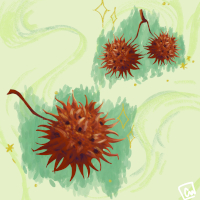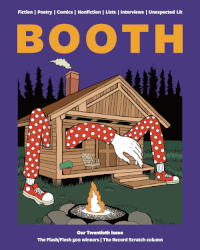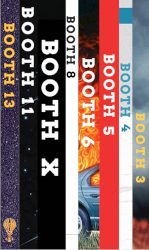by Marya Hornbacher
List: Of Theorems and Proof
1 Theorem One
What we are is a shell, the exoskeleton of space, spirals and chambers in which nothing lives.
2 Theorem Two
What we are: is the logarithmic spiral of the shell (φ, or 1.6180339887 . . . &c.): an irrational number. Extant only in zero-dimensional space.
3 A Problematic Fact
The irrational spiral of shell, extant only in theory, still accounts for the actual echo a child hears, holding the shell to her ear, of an ocean roaring in the farthest chamber, hidden from sight by the shell’s spiral.
4 Which Can Be Understood As
illusion, of course: the whorl of the child’s ear, and the blood in the ear, and the beat of the blood in the ear echo into the spiral, travel through the shell’s chambers into the farthest chamber and then bounce backward through the shell into the skull.
5 The Equation
The growth pattern of each subsequent chamber is phi times the size of the previous. I am speaking of the shell.
6 Theorem Three
What we are is the ear, and the number of chambers that make up the ear, the echoing chambers, the hollows of which we mostly consist.
7 An Alternative Theory
What we are is the child, growing in spirals, each empty space phi times the size of the previous, such that our empty chambers go on forever, such that if you put your ear to us you’ll hear the roar of our ache and our echo, ad infinitum.
8 What There Is on the California Shore
A child in a red sweater. Kneeling in the water. Head bent to the side to listen to the shell. Also cypress, boughs heavy with hanging moss. Black pines and green pines, eucalyptus and the scent of eucalyptus and whoever held the camera and took the picture of the child listening intently to the sound of empty space.
9 The Golden Ratio
What we call beauty: the nautilus shell, the fern as it unfurls, a certain arrangement of bones, the spun helix of DNA. That which is in perfect proportion should be, by all reason, transcendent: a transcendent number, indivisible and endless, like pi.
But the spun strands of which we are made and the spaces of which we consist and the echo and the ache are illusion,
10 Proof
which is to say earthbound, kneeling in the water on the shore, consisting of salt water, and the sound of the blood in our ears, the sound of an ocean that roars deep in us where we do not exist.
List: Of What Lies in the Distance
1. How We Got There
We rode in the back of Nate’s blue truck, passing a bottle of some cheap shit. Our skeletons danced like marionettes as we rattled over the road.
2. What We Wore
Those fake woven Mexican ponchos, cheap at the head shops. In the front pockets, we carried bags of decent Northern California pot, and pipes.
3. How Old We Were
We were fifteen. Nate was seventeen, so he had the truck.
4. The Route
We took the coast road, Highway 1. It ran north and slightly west, through the scattered hill towns that smelled of wood smoke, cedar, sweet rot. I hitched a ride to the main road as the sun slid down behind the eucalyptus trees. The boys tore up around the bend, and I swung in.
5. What It Is
A shallow, rocky inlet of the Pacific Ocean, five miles across, bordered on the north by Bodega Head and flowing south into Tomales Bay. It lies pressed up close against the San Andreas Fault like one body pressed against the length of another, both rippling with seismic shocks.
6. What We Did As We Approached
We lifted our faces to smell for salt, our hair all tangled up with wind. We took slugs off the bottle and howled and laughed. The eucalyptus burned the nostrils and lungs, and so did the sweet cloves we smoked.
7. What This Was Before
This was before he kissed me behind the bloodflower. This was before I knew there was a plant called bloodflower, and one called cathedral bells, before I knew prayer plant, before I could incant them, whispering names as I walked through the dunes, before I walked through the dunes later, alone. Flora that thrive here include purple iceplant, yellow desert daisy, iris, agave, water lily, bleeding heart, flame azalea, rosary vine. This was before the whiskey kiss behind the bloodflower and high sage. This was before the kiss sealed my mouth with death. The boy died. I tasted whiskey when I heard he had. The taste of whiskey on a child’s fevered breath.
8. What Happens There
The road peters out, turns to sand. Now, in the darkness, you can hear it, the heave and crash of the ocean, taste salt spray on your lips. There’s little light, just the truck’s high beams scanning fences, running over the pampas grass’s white plumes. We rattle to a stop, jump out, run barefoot into the dunes. Hissing sand grass rushes against our legs; we stumble on the shifting earth. We build a fire of driftwood scraps, sit with our legs drawn up against our chests. Sit staring into the fire, passing the bottle and the pipe. The black night pours itself into the well of itself.
9. What There Is in the Distance
The brackish marsh.
The wet meadow.
The freshwater marsh.
The tidal lagoon, and the creatures therein.
Sandpiper, egret, blue heron, bobcat, the red-legged frog.
In the sleeping bay, black as oil, the seal, sea lion, and whale.
10. How He Did It
A length of rope.
11. Who Found Him
His brother, after school.
12. What His Mother Did at the Funeral
An interpretive dance. She’d gone crazy years before and no longer spoke. The congregation looked away as she danced up and down the aisles, mimed giving birth, mimed nursing him, rocking him, mimed him hanging from the rope. She held her hands to her throat till she turned purple, tongue lolling from her mouth. Someone had to pry her hands away. Then she sat down.
13. What I Did after the Funeral
Drove north and slightly west through the hill towns where the boys had lived. The sun slid down behind the trees. The smell of eucalyptus burned my nose and lungs. I drove fast, my hair all tangled up with wind. I got out of the car, took off my shoes, walked barefoot through the dunes. The sand was cold and smooth. My lips tasted of whiskey, salt spray, sweet cloves. I walked down to the water. What there is by the water: tide pool, rope of kelp, spume, foam. I walked until I could no longer feel his seeking mouth, his hunger, his unanswerable ache.
List: Of Nine Dreams
1
Somewhere outside a woman is laughing. Last night I dreamed I spoke Spanish. I don’t. I dreamed I knew the words tumelo domo. I dreamed they meant little pig. They do not. I looked them up. They mean burial mound. They mean grave.
2
This is the dream of the centrifuge, or fast dancing. The question is raised: whether to address the theory or, instead, the application of spinning and distribution of dense things equally over a given object or space. Even in the dream, this makes no sense.
3
This is the dream where I’m sick with betrayal. No one betrays me. I have betrayed. I wake reeling, holding my face. I know the face in the dream. Always, I know the face I betray. They cry out when they discover what I’ve done.
4
If I sit long enough in the darkening room, my body disappears piece by piece. My hands are last to be erased. Then, invisible, I go to sleep, and this is when I dream of erasure, of being a thing that, in darkness, is dispersed.
Generally this is when the lover in bed shakes me awake because I am screaming. The lover always says, Shh. It’s all right, it’s all right.
It isn’t, of course. It is not all right.
5
This is the dream where I am shot. Three times. Three times, I die. There is a moment after dying, it turns out, where you think, Is this it? Am I dead? You look around, try to move your arms and legs. But you are only mind, only a searchlight of eyes.
8
What’s known: the mathematics of breathing. You told me this once. You lay sleeping. Eyes closed, you said, It’s simple; each heartbeat is assigned a number of breaths. This number is four. You held your hands this far apart, to show the approximate measure of breath.
I said, You’re sleeping. But you insisted you were not, and perhaps you were not. Perhaps my breath is measured in the space between your hands.
9
In this dream, I am old. It is the dream where I reach up and touch my face. When I take my hands away, they are covered with papery skin, brittle-boned. In the dream, I push through a crowd, search for a mirror, see myself: my hair crow-black and straight as straw. I hold my face in my hands. The skin wrinkles, sags over my fingers. My cheeks become jowls, the skin under my eyes droops until the whites gleam. My mouth comes off, lips curling away from the gums. I am holding my face to my skull.
Vaguely, I know that you are somewhere nearby, maybe somewhere in the crowd, and I know that this is a dream about you.



